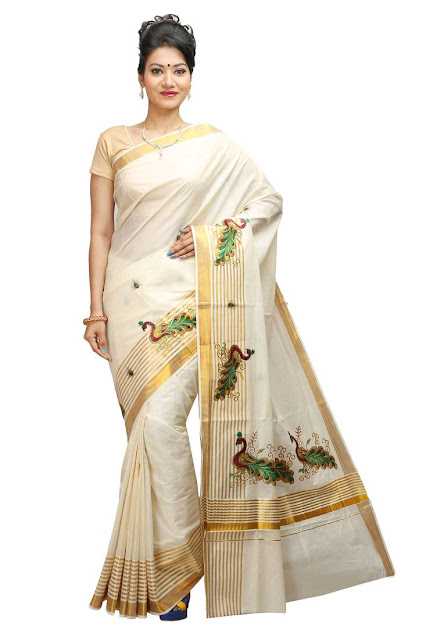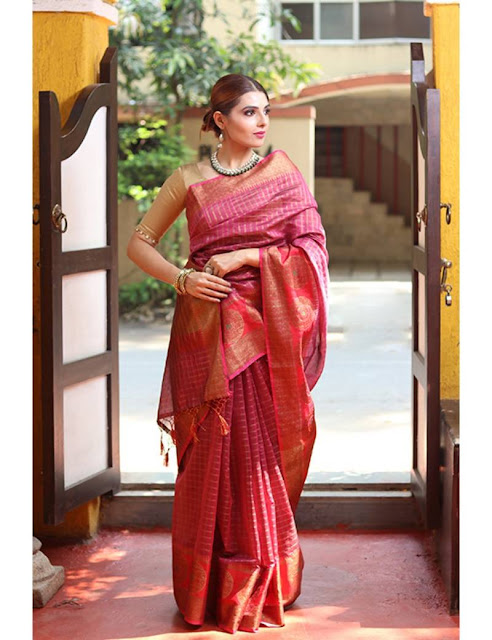Kasavu Saree and Its Cultural Relevance
The festival of Onam marks the Malayalam New Year. It is celebrated in the state of Kerala with great pomp and show. It falls in the month of August-September, also known as ‘Chingam’ in Kerala. It was declared to be the main festival of Kerala in the year 1960, and is celebrated over ten days.
Several traditional games accompany this festival, such as boat- race, Onathallu (a martial art form), etc. Onapookalam or Athapookalam (flower bed) is decorated in every household during this time. The colors that are generally preferred by the mass is white, or other pale colors with borders of Gold. Traditionally women wear Kasavu sarees during Onam and Men don Dhotis to keep their attire culturally relevant.
Cultural Significance of Kasavu Saree
Onam is celebrated in the commemoration of King Mahabali, who rises from 'patala' to meet his folks once every year during this time. He was a righteous king, during whose time, the locals wore attires by weaving threads of gold in cotton. They did so to distinguish the native people from invaders.
Kasavu was traditionally known as ‘Mundum Neryathum,’ which has its roots in the times of Lord Buddha. Gradually this type of attire started becoming popular in South India especially in Kerala, God's own land. This style of saree also has marked Greek influence.
The weaving of Kasavu Sarees
Pit-looms are used to weave Kasavu sarees. In a pit loom, a weaver's lower body is in a pit while he works on the loom. Pit looms are of two types, i.e., the ‘throw shuttle pit loom’ and the ‘Fly shuttle pit loom’. The throw shuttle pit loom is the more traditional one; the productivity of these kinds of loom is comparatively lower. However, a Kasavu saree woven on a throw shuttle pit loom will have a more delicate weaving. The fly shuttle pit loom, on the other hand, has more productivity, but Kasavu sarees that are woven on these kinds of looms are not as fine or smooth.
Some Facts on Kasavu Sarees
The price of real Kasavu sarees tends to be higher because of two primary things. First, they are made of the finest quality silk; second, to form the golden borders of a Kasavu saree, silk yarns are first twisted with silver wires and then dipped in real gold to attain a golden hue, which is then woven on the saree to form those golden borders. So, it is an obvious thing that the broader the border is, the higher the price of the saree, and vice-versa.
As many people cannot afford sarees with real gold and silver, there is a budget-friendly type of this saree as well. This type of Kasavu saree is less costly as synthetic threads in golden color are used to form the borders of the saree in place of real metals. Another up-side of these synthetic types is that it does not lose its sheen with time as the real ones do.
Kasavu Saree: A Product of hard-Labor
We are from a land where our culture means much to us. The main handloom hub of Kasavu saree is in Balaramapuram, a small district in Thiruvananthapuram. A hand-loomed Kasavu saree takes between 3 to 4 days to finish and is considered to be a work of art. While power-loomed products are much cheaper, still the hand-loomed Kasavu sarees have an aesthetic value to it, which cannot be replaced. As a nation that prides itself on its heritage and rich culture, we must put an endeavor to preserve it with our activities by supporting the artisans who gain their livelihood from hand-looming sarees.
Overall, these sarees are stunning and have a simplistic appeal. Many Bollywood divas such as Sonam Kapoor, Vidya Balan, and Aishwarya Rai Bachchan have been spotted flaunting these sarees. If you want your innate grace to shine bright on occasions and ceremonies, you can don a Kasavu saree that is traditionally worn on the festival of Onam in Kerala.






Comments
Post a Comment